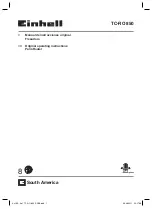
User Manual, MAR-5915-2x
User Manual
Chapter 2 Operation
MNL-0655-01 Rev A6
ECO-5592
Effective: 05 Feb 19
Page 13 of 40
Quick Start Steps
Support Equipment
To configure the DuraMAR 5915-2X, you need the following support equipment:
A computer with at least one RS-232 serial port and a terminal emulator application.
Note: The ROU and SWI portions each have a dedicated console port. Each of the two internal
devices (5915 and ESS2020) must be configured separately via its unique port.
A DC Power Supply with an output of between 12v and 36v (ideally 28v)
Connections
1. Connect a power cable to port J1 on the DuraMAR 5915-2X (use CBL-2417-01 from the starter cable
set, or an equivalent MIL-DTL-38999 power cable).
2. Connect the other end of the power cable to the
unpowered
DC power source.
Caution! Make sure that the DC power source is set to provide 12 to 36VDC (28V nominal).
3. Connect a serial cable to the serial port on the host PC and to
J3 (for ROU configuration) or J6/J9 (for SWI configuration).
Note: To use the J9 console, remove the cover plate over connector J9. Save the cover and
screws; J9 should be covered when not in use. Connect CBL-1536-01 between J9 and the host
PC serial port.
Caution! Do not connect to both SWI console ports at the same time.
J6 Console and J9 Console are the same port. Connecting to both ports will result in an electrical
conflict on both connections.
4. Open a terminal emulator on the host PC.
5. In the PC terminal emulation software, configure the serial port for 9600 bits per second, 8 data bits,
no parity, 1 stop bit, and no flow control.
6. Apply power.
7. Use the command line interface (CLI) to enter commands to configure the equipment. See the
software configuration guide and command reference from Cisco for more information (refer to the
next section on System Configuration).
8. Connect Ethernet devices as required to J2, J6, J7 and/or J8.
Note: To prevent the user from interchanging cables for J3, J6 and J7, these connectors and
consequently, their mating cables, are keyed differently.
Refer to Table 1 to determine the correct cable for each connector














































